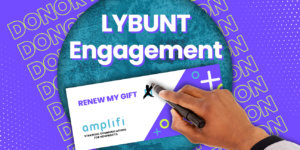Would you believe us if we said you could get a solid idea of why your online giving strategy is falling short with one simple exercise?
You know the details about your organization and your donors better than anyone. But it can still be helpful to put yourself in your donors’ shoes. After all, it can be hard to disconnect and see things from an outside perspective when you live, eat, and breathe your nonprofit’s mission.
And donating to your own nonprofit through your online giving page is a great way to get a better feel for a donor’s experience!
Conversion rates, donor retention rates, and other data points can tell you if your online giving strategy is working. But these raw numbers can’t tell you why donors are engaging (or not) the way they are.
A poor conversion rate could indicate problems with your online giving strategy. And to fix it, you need a better grasp on what’s causing donors to leave your website before giving. Or why they never gave again after their initial gift.
Are you ready to take a hard look inward and evaluate your digital fundraising strategy?
Then go to your nonprofit’s home page and simulate an online donor’s journey. Make your way to your online giving page and make a $5 donation. Then, keep these four things in mind as you walk a mile in a donor’s shoes.

Is it easy to give?
This one should be a no-brainer for you. After all, you know mobile optimization, offering multiple ways for donors to give, and minimizing the number of clicks makes it easier for donors to give.
But for this exercise, we want to think more holistically. That’s why it’s important to start this process on your home page, not your online donation page!
Is it easy to get from your home page to your online donation page? Remember, your audience isn’t familiar with your site. They won’t know to look in a drop-down menu to find your online giving page.
So, you should feature obvious call-to-action buttons that direct visitors to your donation page.
And your site should also have plenty of educational materials about your mission and work to engage potential new donors. You should present this information in a way that effortlessly steers visitors to your giving page.
Optimizing your online giving strategy with shorter forms, pre-filled information, and several payment options won’t do any good if there’s not a clear, engaging path for donors to give.
But don’t just take our word for it! According to Next After, a simplified decision process and contextual landing page design can improve a nonprofit’s conversion rate by 14.4 percent!
Donating to your own organization will help you determine if your site structure, calls-to-action, or load speeds are holding your fundraising back.
Do donors understand their impact?
Are you helping your supporters envision what their donations will do to further your nonprofit’s goals?
You need to constantly remind donors of the impact they make when they give. Remember, a picture is worth 1,000 words, so use images of your work in action to show the impact of giving.
You should also tie gift amounts to something that feels real for donors.
For example, “Your gift of $100 will provide two classrooms with supplies for a year.”
Comparing dollars to impact helps make a donor’s gift feel less abstract. Someone may struggle to see how a donation of $100 is significant when your campaign goal is $50,000. But if they understand how their gift makes an immediate difference for two classrooms, they are more likely to donate!
So, as you go through the donor journey, note how your communications talk about the difference every donation makes. You have some work to do if your website only features things like the percentage to your goal, total dollars raised, and overviews of specific programs.
Donors need to understand how their fundraising dollars put your mission to work. Doing so can increase the amount a donor wants to give! And it makes it clear that they can do a lot more for the cause by giving just a few more dollars.
READ MORE: The right way to compare dollars to impact.

How do you thank donors?
If you don’t thank donors properly, your chances of securing a second gift plummets. So, you should thank a donor three times within 48 hours of their donation.
The first time is on your website when they click “Donate.”
So, once you’ve filled out your own donation form (hopefully, that wasn’t a hassle!) and clicked the donate button, you wait a few seconds as the wheels spin. Then a page pops up with the words “THANK YOU!” in a large font.
But this page can do more. It should reinforce the impact a gift has on your goals. Consider using a happy picture of the people you support on this page. However, if this is the only element of your stewardship strategy, you’re making a big mistake!
You also need to confirm when a donor’s gift has been received. So, send a digital receipt as soon as the transaction is processed. Your donors may need this for tax purposes, so don’t leave them hanging.
And don’t forget, this is another opportunity to say thanks!
Finally, you will want to follow up with a more elaborate thank you. This is your opportunity to show how important every donation is to your nonprofit.
You can send an email. But picking up the phone or sending a handwritten note is a much more personal approach. This is your opportunity to tell donors the next chapter of your story. So, share the specific ways their donation is already making a difference.
READ MORE: Can your nonprofit send better thank you’s?

Do you keep donors engaged?
Your work is still not done. This experiment of donating on your own website is ongoing!
Fast forward months from now. What kind of emails are you getting from your nonprofit? This step may not even occur to you until you see an appeal email about your latest initiative.
Remember, we’re thinking in the donors’ shoes. How would you feel if you were ignored for months after your first gift and only heard back when the organization needed more money?
Probably not great! And that’s why it’s important to continue building the relationship over time.
As you know, you need to develop a communications strategy that keeps donors engaged and excited to give the next time you ask.
So, make sure to include plenty of touches that don’t ask for a donation. This can include your new donor welcome kit, invitations to events and volunteer opportunities, donor surveys, and newsletters highlighting your mission.
Record, review, and report.
But this exercise can only help you if you maintain good data hygiene. So, make sure you’re vigorously taking notes throughout the entire process. You will need organized, qualitative data to identify the gaps in your online fundraising strategy and make changes that improve the donor experience.
Remember, no two donors are the same. So, you should encourage more than one person in your organization to try this exercise. It’s better to get a variety of opinions about your approach!
Then, you must analyze your findings and determine the best way to improve your strategy. You will then need to organize your notes, so you can report what you’ve learned to the decision-makers in your organization. Unless that is you, of course!
You know it’s important for donors to understand the impact of their gift. And this experiment will help you understand the effect of a sub-par online giving strategy.
Donating to your own organization will help clarify the reasons you struggle and paint a picture of what you can do to improve your results.









